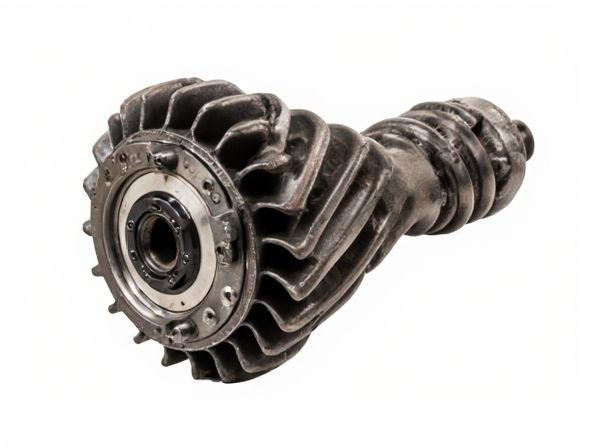
Photo illustration: Helical Differential vs Clutch-type Differential
Helical differentials provide smooth and efficient power distribution between wheels by using angled gears, reducing wheel slip and improving traction on slippery surfaces. Clutch-type differentials use friction plates to control torque transfer, allowing for adjustable locking and better performance in off-road or high-torque situations. Your choice depends on the driving conditions and desired balance between smooth handling and traction control.
Table of Comparison
| Feature | Helical Differential | Clutch-type Differential |
|---|---|---|
| Working Mechanism | Uses angled helical gears for torque distribution | Uses friction clutches to limit wheel slip |
| Torque Distribution | Automatically redistributes torque to wheel with more traction | Manually or automatically adjusts torque using clutch engagement |
| Maintenance | Low maintenance, sealed unit | Requires periodic clutch inspection and replacement |
| Performance | Smooth engagement, better for on-road conditions | High torque transfer capability, suited for off-road and racing |
| Cost | Generally costlier due to complex design | More affordable and easier to manufacture |
| Durability | Long lifespan, resistant to wear | Clutches wear over time, may require replacement |
Introduction to Differential Systems
Helical differentials utilize spiral gears to distribute torque smoothly between wheels, enhancing traction and reducing wheel slip in varying road conditions. Clutch-type differentials employ friction plates to control torque transfer, providing better handling in off-road or high-performance driving scenarios. Both systems are integral to vehicle drivetrains, ensuring optimal power distribution and stability during cornering and uneven terrain navigation.
Overview of Helical Differential
Helical differentials use angled helical gears to distribute torque smoothly between the wheels, enhancing traction and handling on slippery or uneven surfaces. Unlike clutch-type differentials, which rely on friction plates to transfer torque, helical differentials provide seamless torque biasing without the need for electronic controls or maintenance. This design offers improved durability, quieter operation, and consistent performance in various driving conditions.
Overview of Clutch-type Differential
Clutch-type differentials use friction plates to control torque distribution between wheels, allowing for adjustable slip based on traction conditions. These systems provide improved cornering stability by limiting wheel spin during power transfer, making them suitable for performance vehicles and off-road applications. The torque bias capability of clutch-type differentials enhances vehicle handling by managing power delivery more precisely compared to helical differentials.
Working Principles: Helical vs Clutch-type
Helical differentials use angled helical gears that engage smoothly to distribute torque between wheels based on traction conditions without requiring external input. Clutch-type differentials rely on multiple friction clutches that engage or disengage to transfer torque, providing controlled slip by mechanically locking wheels when necessary. The helical design enables seamless torque biasing through gear geometry, while clutch-type differentials depend on frictional force modulation for torque distribution.
Performance Characteristics Comparison
Helical differentials provide smooth torque distribution by employing angled gears that automatically adjust to traction variations, resulting in enhanced cornering stability and reduced wheel slip in various driving conditions. Clutch-type differentials utilize friction plates to engage and transfer torque between wheels, offering adjustable locking capabilities that improve traction on uneven surfaces but may introduce wear over time. The helical design excels in low-maintenance performance and seamless torque modulation, while clutch-type differentials are preferred for customizable locking and improved off-road traction control.
Durability and Maintenance Factors
Helical differentials excel in durability due to their continuous gear mesh design, which reduces wear and extends service life under high torque conditions. Clutch-type differentials require regular maintenance, such as clutch pad replacements, because friction components wear out faster during aggressive driving or off-road use. Maintenance costs for helical differentials are generally lower, making them more reliable for long-term, rugged applications.
Traction and Handling Differences
Helical differentials improve traction by using angled gears that automatically distribute torque to the wheel with the most grip, enhancing stability on slippery surfaces without the need for driver intervention. Clutch-type differentials rely on friction plates to transfer torque between wheels, offering more controlled torque distribution but potentially requiring maintenance due to wear. In terms of handling, helical differentials provide smoother, more predictable cornering dynamics, while clutch-type differentials can deliver sharper response and tighter control during aggressive driving or off-road conditions.
Cost Considerations and Value
Helical differentials offer lower maintenance costs due to their preloaded gear design, which reduces wear and extends service intervals, making them a cost-effective option for long-term use. Clutch-type differentials have higher initial costs but provide customizable torque distribution, which can add value for performance-oriented applications. Choosing between these differentials depends on balancing upfront expense against functional benefits tailored to specific driving conditions and vehicle requirements.
Applications in Modern Vehicles
Helical differentials provide improved traction and smoother power distribution in all-wheel-drive and performance vehicles by using angled gears that automatically transfer torque to the wheel with more grip. Clutch-type differentials, commonly found in high-performance sports cars and off-road vehicles, offer adjustable torque transfer by engaging friction plates for better control during cornering or slippery conditions. Modern vehicles integrate these differentials to enhance stability, handling, and drivetrain efficiency based on specific driving demands and terrain.
Choosing the Right Differential for Your Needs
Choosing between a helical differential and a clutch-type differential depends on driving conditions and performance requirements. Helical differentials provide smooth, automatic torque distribution ideal for everyday driving and off-road traction, while clutch-type differentials offer customizable locking for aggressive handling and track use. Evaluating factors such as vehicle type, intended use, and budget ensures selecting the optimal differential for enhanced control and durability.
 caratoz.com
caratoz.com